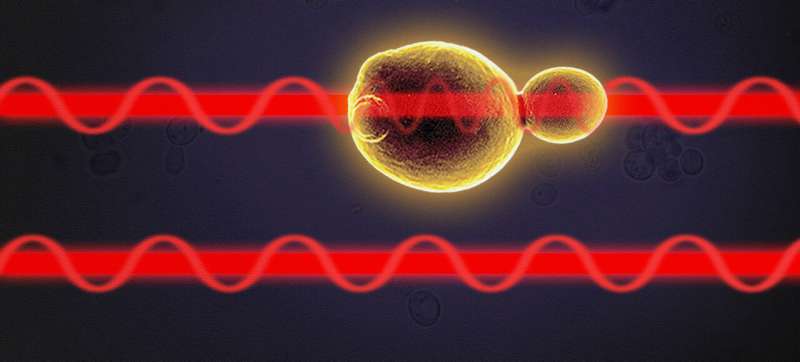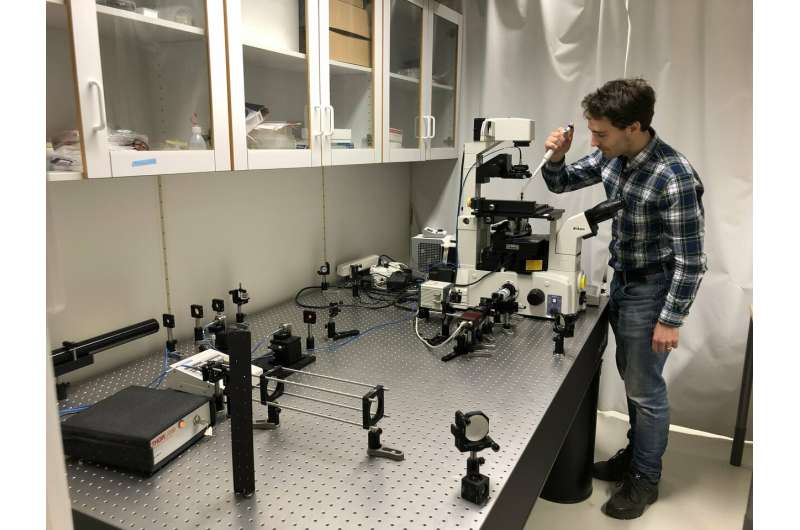Investigating cell stress for better health—and better beer

Human beings are not the only ones who suffer from stress—even microorganisms become stressed out. Now, researchers from Chalmers University of Technology, Sweden, have devised a new method to study how single biological cells react to stressful situations. Understanding these responses could lead to more effective drugs for serious diseases. Additionally, the research could even help to brew better beer.
All living organisms can experience stress during challenging situations. Cells and microorganisms have complicated systems to govern how they adapt to new conditions. They can alter their own structure by incorporating or releasing many substances into the surroundings. Due to the complexity of these molecular processes, understanding these systems is a difficult task.
Chalmers researchers Daniel Midtvedt, Erik Olsén, Fredrik Höök and Gavin Jeffries investigated how individual yeast cells react to changes in the local environment—in this case, an increased osmolarity, or concentration, of salt. They both identified and monitored the change of compounds within the yeast cells, one of which was a sugar, glycerol. Furthermore, they were able to measure the exact rate and amount of glycerol produced by different cells under various stress conditions. Their results have now been published in Nature Communications.
"Yeast and bacteria have very similar systems when it comes to response to stress, meaning the results are very interesting from a medical point of view. This could help us understand how to make life harder for undesirable bacteria that invade our body—a means to knock out their defence mechanisms," says Daniel Midtvedt, researcher in biological physics at Chalmers, and lead writer of the scientific paper.

He has been researching the subject since 2015, and, together with his colleagues, has developed a variant of holographic microscopy to study the cells in three dimensions. The method is built upon an interference imaging approach, splitting a laser beam into two light paths. One passes through a cell sample, and one does not. The two beams are then recombined at a slight offset angle. This makes it possible to read changes in the cell's properties through the variations in beam phase offsets.
With this method of investigating a cell, researchers can see what different microorganisms produce under stress—without using traditional 'label-based' strategies. Their non-invasive strategy detects multiple compounds simultaneously, without damaging the cell.
The researchers now plan to use the new method in a large collaboration project, to look at the uptake of targeted biomedicines.

"Hopefully, we can contribute to improved understanding of how drugs are received and processed by human cells. It is important to be able to develop new type of drugs, with the hope that we can treat those illnesses which today are untreatable," says Chalmers professor Fredrik Höök, who leads the research centre Formulaex, where AstraZeneca is the leading industry partner.
As well as the benefit to medical researchers, improved knowledge of the impact of stress on yeast cells could be valuable for the food and drink industry—not least, when it comes to brewing better beer. "Yeast is essential for both food and drink preparation, for example in baking bread and brewing beer. This knowledge of yeast cells' physical characteristics could be invaluable. We could optimise the products exactly as we want them," says Daniel Midtvedt.
More information: Daniel Midtvedt et al, Label-free spatio-temporal monitoring of cytosolic mass, osmolarity, and volume in living cells, Nature Communications (2019). DOI: 10.1038/s41467-018-08207-5
Journal information: Nature Communications
Provided by Chalmers University of Technology

















